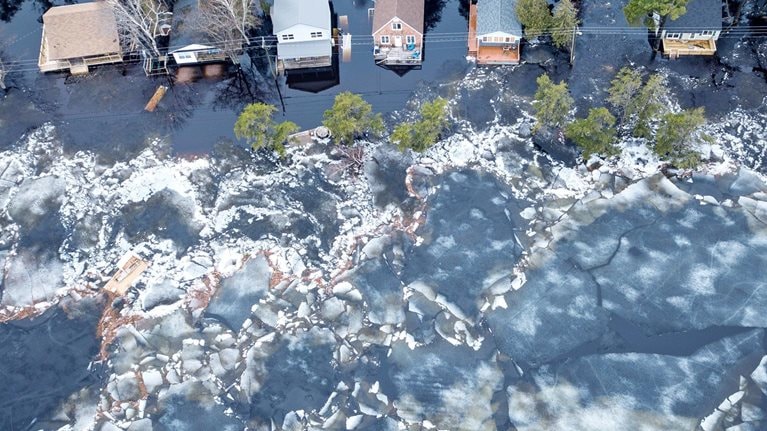Property and casualty (P&C) insurers have been facing mounting pressures on claims expenses and loss ratios due to market forces such as rising inflation, global supply chain issues, and an increase in catastrophic events. Against this backdrop, it’s critical for insurers to prioritize strategies that alleviate short-term pressures and prepare for the next normal in claims,1 all while the claims function broadens its scope beyond the traditional dimensions of efficiency, effectiveness, and customer satisfaction to include employee satisfaction and sustainability.
In this article, we focus on sustainability and outline how insurers can manage the environmental impact of claims to work toward their decarbonization targets. Insurers with strong environmental commitments have begun to examine their claims emissions and set decarbonization targets. The claims function hits a sweet spot. Our analysis shows that the function accounts for a large share—85 percent—of operational emissions2; it’s at least somewhat under insurers’ control; and it’s an opportunity to create positive outcomes for both the business and customers.
Reducing claims emissions can also be an opportunity to rethink fundamental elements of the now decades-old approach to claims management and supply chains. Some possible results include optimized claims-management spending, higher productivity and efficiency, and the execution of insurers’ overall sustainability strategies. Significantly, performing to the expectations of investors, customers, and employees can also lead to higher stakeholder satisfaction and opportunities for growth.
To maximize the impact of their work on claims decarbonization, insurers should consider quantifying their baseline levels of emissions from claims (using established frameworks for corporate decarbonization target-setting and science-based methodologies); they should also identify the strategies that would help reduce emissions from claims and manage their business accordingly. To achieve these results, the claims function must be centered on sustainable claims management. Time is of the essence.
The opportunity in decarbonizing claims
Moving toward lower emissions in claims is about more than meeting stakeholder expectations. Insurers that effectively seize the moment can create better outcomes for the environment, customers, and their bottom lines.
In the short term, insurers can flex the power of the purse—they have considerable control over how claims are resolved—to decarbonize claims and support environmental sustainability. For instance, insurers could provide incentives to suppliers to use renewable energy and green parts in their repair and replacement processes, thereby reducing the emissions required for effective claims management.
Reducing emissions can also strengthen insurers’ green credentials among their stakeholders. Consider that investors and customers increasingly want to see insurance carriers move from public commitments to decarbonization to action. In a survey of global institutional investors, about 56 percent listed greenwashing as their primary concern in the market.3 Customers also increasingly value sustainability, which makes sustainable claims processes a significant source of value and differentiation that customers can personally experience.4 This alignment with customers’ environmental priorities can help insurers retain customers over time.
These actions can also strengthen insurers’ businesses. Of course, insurers may balance the benefits of decarbonization against additional costs. In the short term, insurers can decarbonize by sourcing low-emission solutions to resolve claims while also reducing costs. For instance, repairing a damaged windshield instead of replacing it with a new one might save about €1,200, on average, and reduce emissions by 99 percent.5 On a longer time horizon, decarbonizing claims can create positive spillover effects in underwriting-linked emissions. Our analysis shows that these emissions account for about 45 percent of European and UK insurers’ total attributed emissions (a share of emissions produced by businesses and individuals are attributed to insurers that underwrite them). Take a scenario in which a UK-based customer submits a claim for a broken window. If the insurer replaces the window with sustainable, energy-efficient glass that reduces heat loss from the house, the property’s carbon emissions will be 330 to 405 kilograms lower every year as a result and reduce total underwriting emissions from heat loss by about 20 percent.6 The customer would also benefit from lower energy bills.
Moving toward claims decarbonization
Insurers have compelling regulatory and business reasons to move toward decarbonization in claims. To maximize their odds of success, they could act now by evaluating the starting point for their claims emissions, identifying and prioritizing the strategies needed to decarbonize—and when to implement them—and embedding the changes in their organizations. This undertaking would require effort, particularly in analysis and planning, to pinpoint areas with high potential for emission reductions and to develop the right decarbonization approaches. Getting started as soon as possible is important, so insurers could use data and inputs—whose quality tends to improve over time—to refine their approach.
Quantify the baseline and use the outcome to plan
Understanding their current emissions in detail is a critical first step for insurers and is a no-regrets move. It would allow insurers to identify significant sources of emissions in their claims portfolios, design ways to target these hot spots for maximum emission reductions, measure decarbonization progress, and communicate fact-based recommendations to customers. To tease out the richest insights, decision makers could use their data to trace emissions to different types of claims along dimensions such as peril type, damage severity, risk mix segment (such as detached buildings), and resolution (Exhibit 1). For example, insurers could compare the quantified impact of prioritizing vehicle repairs over write-offs in cases of similar damage severity.

Establishing a reliable baseline requires three key components.
1. A data-driven, transparent approach grounded in science-based targets. Best practices can help private-sector entities reduce emissions in ways that can help meet the goal of the Paris Agreement to limit global warming to 1.5°C above preindustrial levels.7 However, quantifying the baseline level of emissions from claims in the first place is difficult because the industry lacks a commonly accepted method to estimate emissions from claims—which mostly come from the parts and labor required to repair and replace any assets. The industry lacks not only a shared carbon accounting methodology but also an agreed-upon way to attribute emissions from the claims process to insurers—the point at which insurance customers’ emissions in the claims process would be counted as part of an insurer’s emissions.
2. Rich decarbonization data. Insurers understand their own claims data along the dimensions of peril, type, and severity. However, the industry lacks a database of emissions associated with different components that may be involved in a claim, such as a repaired bumper. A data source that helps quantify emissions in claims can help business leaders develop plans to move toward emission-reduction targets and translate them to action (for one example, see sidebar, “An approach to estimating claims emissions”).
3. A forward-looking view. Once insurers establish their baseline emissions, they can look ahead to macro forces that may affect different components of their claims emissions to prioritize strategies to transform their claims processes. For example, parts of the economy, such as plastics and steel manufacturing, are already undergoing significant decarbonization. This development will automatically reduce emissions from auto parts in the future, which means auto parts may contribute to reduced emissions in the near future but have limited impact in a few years.
By contrast, some components of the claims process may become more emissions intensive over time. For instance, our research shows that replacing the battery of an electric vehicle during the repair process might result in three times the emissions of a similar claim for an internal-combustion-engine vehicle.
Identify—and balance—the right strategies
After establishing a baseline, insurers can develop a series of targeted approaches to transform their claims processes to reduce emissions. Some of the approaches could create significant savings, some are close to cost-neutral, and others require significant investments (Exhibit 2).

For instance, our analysis suggests that the UK P&C insurance industry—with £20 billion in gross written premiums—could save up to £500 million by optimizing indemnities while still pursuing actions that reduce emissions. Done in the right sequence, these activities can help insurers make progress on decarbonization efforts without negatively affecting loss ratios.
Emissions can be reduced in three key areas:
1. Embed emission reduction at the product level. Specifically, insurers could redesign policies to enable sustainable claims handling and encourage repairs using lower-emission options. New policies could promote alternatives such as certified green repair shops or repairs over total loss where appropriate. Incentives and nudges toward safer and more sustainable behaviors could also help manage claims frequency.
2. Optimize the claims process. Claims handlers can make decisions at pivotal points throughout the claims life cycle to reduce emissions. For instance, they could prioritize digital inspections instead of on-site ones, recommend repairs instead of replacements for lower-severity cases, and lower the distances covered by tow trucks by routing claims to the nearest repair shops.
3. Decarbonize the claims value chain. Supplier management will be critical because claims emissions are mostly a product of suppliers that perform repairs and replacements. Motivating suppliers to reduce their emissions and monitoring them would deliver the majority of direct reductions of emissions in claims. For instance, insurers could improve recovery rates in cases of total loss by salvaging a higher share of emissions-intensive materials, such as aluminum. Decision makers could also intentionally build up a separate value chain of recycled parts so partners could more easily opt for lower-emission materials. Once lower-emission inputs are available, insurers could also offer incentives for repair shops and other partners involved in fulfilling claims to operate within the lower-emission value chain and could promote partners that are certified users of green energy.
Of course, insurers would need to examine the potential impact of decarbonization efforts not only on emissions but also on costs and customer satisfaction. After all, changes to the claims process could result in negative responses from claimants. Recent research suggests that customers increasingly favor more-sustainable options for handling claims. For example, about 70 percent of motor insurance customers said they would choose a green replacement part for a vehicle repair and cited protecting the environment as the main motivation.8
And while decarbonizing claims presents opportunities for both insurers and customers to benefit, insurers would need to examine any additional investments required and fully understand the complexities that different types of approaches may bring before they commit to a course of action. Not every insurer could follow through on every possible tactic. For instance, the large-scale use of recycled parts will likely only be feasible for market leaders or owners of large repair networks that generate a large number of reusable parts in the course of their activities.
Finally, local regulations necessarily affect the feasibility and applicability of strategies to decarbonize the claims value chain. For instance, insurers promoting low-emission solutions in the US market could present the full array of options to claimants and educate them on how to make these decisions.
Align claims with reducing emissions
Claims may traditionally be framed as a function with three elements: indemnity, expense, and customer experience. Aligning the function with sustainability goals is a significant change that adds lower emissions as a fourth element. Focusing on decarbonizing claims involves establishing a baseline and then aligning insurers’ people, processes, technology and data, and service-provider management with the goal.
The process may not be linear. Consider how establishing a baseline requires technology and data. Specifically, technology systems could be adapted to track and quantify CO2 emissions generated by each claim at the invoice level, but doing so requires robust and reliable data on both policies and claims. Over time, this technological change would generate granular data on every element of claims’ emissions.
To put a decarbonization plan into effect, insurers could then consider their people. The right stakeholders—claims handlers and leaders in claims and throughout each insurer—could be educated on the importance of claims processes’ role in working toward lower emissions. For instance, claims handlers could receive training on sustainability, claims emissions assessment, and emission-reduction measures.
Insurance carriers could also reengineer processes so claims handlers have a clear framework for assessing emissions from claims and implementing lower-emissions remedies whenever possible. Finally, P&C insurers could encourage third-party service providers to reduce emissions from their repair and replacement activities. To be sure, the task will be daunting because insurers’ supplier value chains are large and fragmented, but it is a critical piece of the claims decarbonization puzzle.
Decarbonizing claims will involve overcoming complexity and challenges, but insurers have a meaningful amount of control over how they get there. Decisive movement—and progress—can set insurers up to be leaders in the effort.


